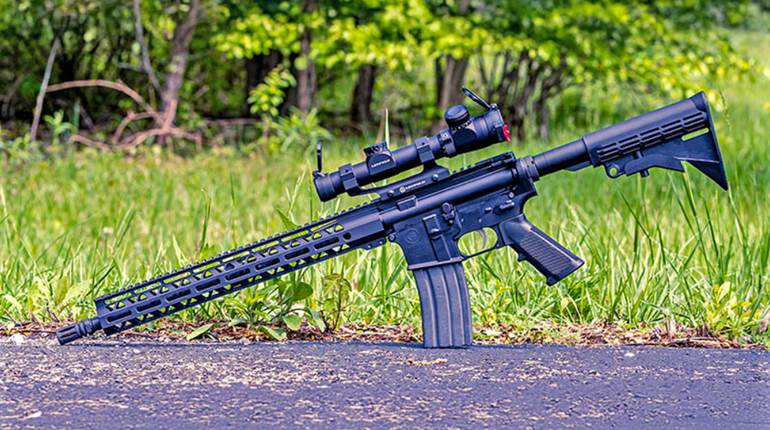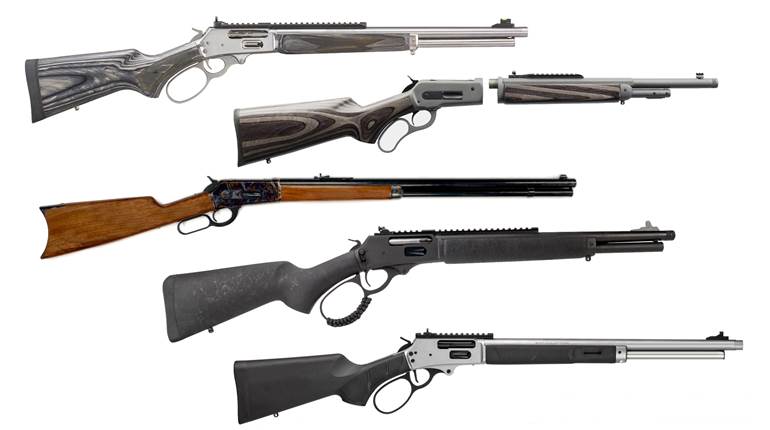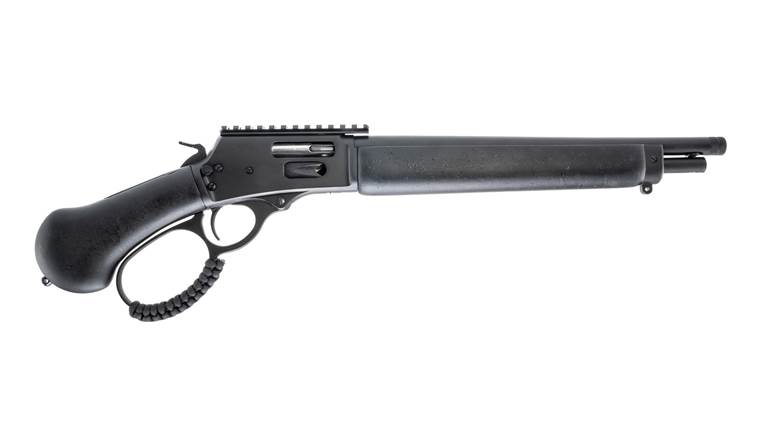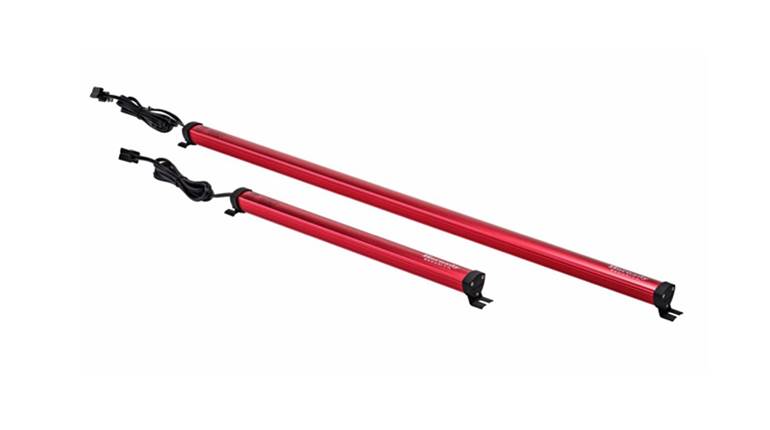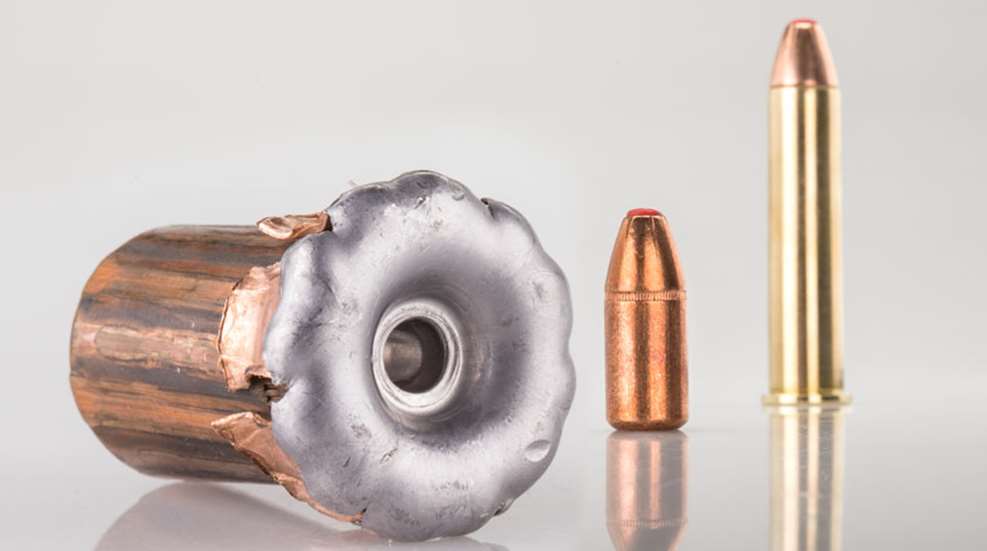
Hornady inaugurated its Subsonic line back in 2018 with a single 190-gr. .300 Blackout offering, and while that product was not its first subsonic load, or even its first subsonic Blackout load, it did mark the introduction of the company’s Sub-X (Subsonic eXpanding) projectile—a bullet tailor-made for performance at velocities well south of the sound barrier. Since its launch, I’ve been quite impressed by this initial loading, finding it to be reliable, capable and an ideal choice for suppressed defensive applications. In fact, it’s the ammunition that now habitually resides within the magazines of my primary home-defense carbine. So I’ve been curious ever since to see in which direction Hornady would choose to take Sub-X next, and I’m honest enough to admit that my best guess wasn’t even remotely close.
That first load didn’t make too many waves upon its introduction to the civilian market (the Department of Defense, on the other hand, recently adopted the law enforcement version for close-quarters use by one of its specialized units) because a new subsonic .300 Blackout ammunition really isn’t terribly huge news these days. They’ve been a major part of the cartridge’s appeal since its original development, and options now abound. Given its reputation for subsonic suitability, starting the Subsonic series with .300 Blackout was appropriate but predictable—which makes what happened next all the more unexpected.
Last year, Hornady came from way out of left field to announce three new Sub-X-topped, heavy-for-caliber subsonic hunting loads chambered in .30-30 Win., .450 Bushmaster and .45-70 Gov’t—a trifecta of rifle cartridges never previously envisioned (beyond the imaginations of handloaders and a few nichey, small-batch makers) as outlets for subsonic use. Another subsonic Blackout option, even a particularly good one, might not have gotten the blood pumping, but a behemoth 410-gr. .45-70 pill that is remarkably pleasant to shoot, safe through a .45-cal. handgun suppressor and that has been designed from the ground up to reliably expand inside game even at velocities well below the speed of sound—now that’s something to get excited about!
Devising an effective subsonic hunting load is more problematic than it may initially seem. With the velocity side of the equation capped by the sound barrier (approximately 1125 f.p.s. at sea level), the available kinetic energy is likewise limited—which makes the trustworthy, effective terminal ballistic performance of the bullet all the more vital—an engineering feat far more difficult at low velocities than it is at blistering ones.
Unfortunately, up to this point in time, the field results from some of the market’s existing options have been found by shooters to be less than satisfactory, and some diehard hunters I know ardently refuse to use subsonic ammunition for the taking of game as a result of this. While I don’t share their absolutist point of view on the subject, I do understand their concerns, as subsonic ammunition does shrink the hunter’s margin for error considerably.

Ammunition that dumps a ton of energy into the target upon impact can often compensate for subpar shot placement, as the temporary wound cavity may damage vitals that the projectile itself did not. But given the necessarily less-energetic payloads possessed by subsonic hunting loads, that way of thinking isn’t going to cut it here. The bullet itself needs to be well-placed, and it must efficiently use the relatively meager amount of energy that it does have available—creating as substantial a wound as is physically possible by expanding impressively while simultaneously holding together to penetrate deeply—even at impact velocities far below where most bullets are capable of functioning properly.
Hornady claims to have cracked the code with its Subsonic cartridges, however, due to the extra significance of a properly performing subsonic projectile, I sought to validate the company’s confidence in Sub-X by way of a full battery of tests on the NRA Publications test range. But before we explore the load’s range results, let’s first take a look at the technical details of Subsonic’s design.
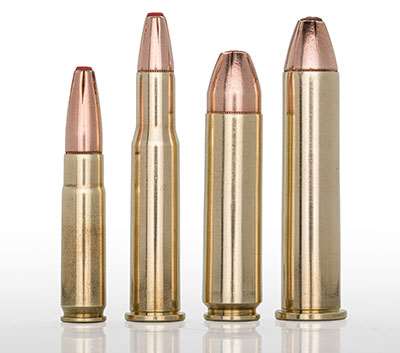
The Design
Given that a subsonic load’s maximum velocity is dictated by the sound barrier, ammunition manufacturers must rely on particularly heavy-for-caliber bullet weights in order to generate energy, and the three new Hornady offerings are no exceptions. The recent additions to the Subsonic family are all bruisers for their chamberings—a 175-gr. load for the .30-30 Win., a 395-gr. for the .450 Bushmaster and a 410-gr. for the .45-70 Gov’t. And while the size and shape of each of the three new projectiles are obviously different, the details of their construction are not.
The Sub-X bullet makes use of a lead core with a gilding metal jacket, all three new versions employing a secant ogive, a flat base and a long shank with a crimping cannelure. The nose cavity of each projectile is also topped by the company’s distinctive red Flex Tip to help ensure successful flowering of its six petals upon impact with the target. But while Sub-X may appear outwardly similar to many of Hornady’s polymer-tipped supersonic hunting bullets, a few small alterations do betray its subsonic intent.
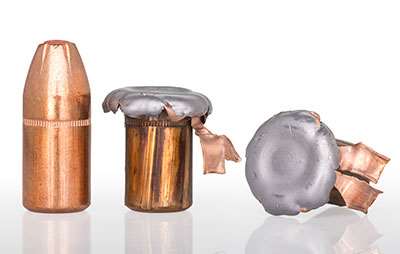
Not only does its tip differ in terms of shape—Sub-X features a relatively wide, blunted meplat rather than the more spitzer-shaped points of its siblings—but also in terms of composition, as the subsonic Flex Tips are noticeably softer and more pliable. This flattened meplat increases the projectile’s frontal area and acts as a hydraulic wedge, generating more outward-pushing force to help initiate expansion at impact velocities as low as 900 f.p.s. The serrations on the bullet’s petals are also longer than those used in other expanding Hornady loads, further facilitating dependable terminal performance at relatively slow speeds.
With its massive bullets taking up so much space within Subsonic’s brass cases, the proper selection of propellants comes even more into play, and for these loads Hornady naturally chose ones optimized for subsonic use—bulky powders that build pressure without producing too much speed. Emphasis was also placed on minimizing flash signature and, given the frequent use of silencers with subsonic ammunition, burning cleanly.
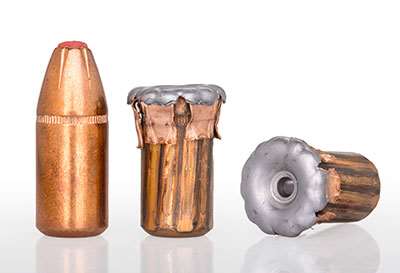
According to company figures, through 24" test barrels, Hornady specs the .30-30 and .450 loads to run 1050 f.p.s. at the muzzle, with the .45-70 loaded slightly hotter at 1075 f.p.s. This results in 428 ft.-lbs. of muzzle energy for the .30-30, 967 ft.-lbs. for the Bushmaster and 1,052 ft.-lbs. for the .45-70. While these energy levels are fractions of what could be expected from these chamberings’ respective supersonic loads, their subsonic qualities do help them to shed that energy more slowly in flight than a supersonic projectile would.
How so? During supersonic flow, the bullet compresses the air in front of it, with the air likewise pushing back to arrest its motion, which is actually what creates the “sonic boom” shock wave that we associate with an object breaking the sound barrier. However, during subsonic flow, the air has time to simply slip around the bullet in flight, allowing it to decelerate at a much slower rate.
Don’t get me wrong, even at their supersonic fastest all three of these chamberings are recognized for having rainbow trajectories that relegate them to being strictly short-range propositions. But between their natural propensity to shed velocity slowly and the ability of Sub-X to expand all the down to 900 f.p.s., each of the three Subsonic options should continue to perform out to roughly 250 yds.—which is about all you can ask of these three cartridges anyway. Plus, their long-for-caliber natures make the three Subsonic hunting loads inherently good penetrators, with sectional densities ranging between 0.264 and 0.279.

In general, subsonic ammunition operates at much lower pressures than does that cartridge’s supersonic options, and .30-30 Win., .450 Bushmaster and .45-70 Gov’t in specific are all relatively low-pressure rifle chamberings to begin with. As a result, Subsonic is comparatively easy on a firearm, the operating pressures of the three new hunting loads ranging from only 15,000 to 22,000 p.s.i. This consideration is particularly meaningful in regard to the .45-70 iteration, as not all of the actions designed to fire that cartridge can handle modern, full-pressure ammunition, and Subsonic can safely be fired through all of them.
This is also very good news for suppressor owners, as, according to Hornady (although it would still be prudent to check with a given can’s maker), the .450 Bushmaster and .45-70 Gov’t loads are low-pressure enough to allow for their use with .45-cal. handgun silencers—unlike these cartridges’ supersonic ammunitions, which typically require the use of a rifle-rated .45-cal. suppressor. Given that virtually every silencer manufacturer on the market offers an example of the former, and that the latter are larger and heavier, more expensive and far harder to come by, this is a pretty big deal. And with the concept of the “tactical,” threaded-barreled lever gun booming right now, and some great majority of the world’s .30-30s and .45-70s being lever-actions, Hornady’s timing in releasing suppressor-capable loads for these rifles could not have been any better planned.
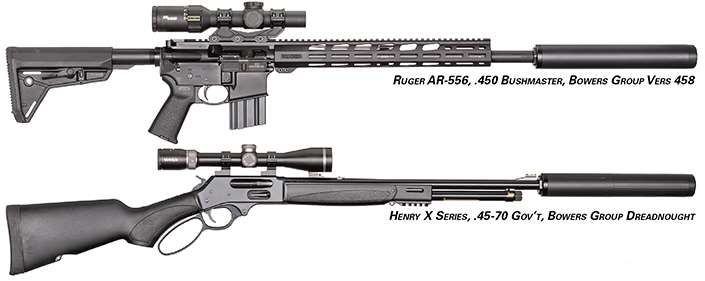
The Data
With all due respect to the .30-30 Win. offering, it was primarily the two new .45 loads that piqued my interest in the 2020 additions to the Subsonic series. So, following SHOT, I immediately requested from Hornady as many boxes of the .450 Bushmaster and .45-70 Gov’t ammunition as the company was willing to send.
I also arranged with Ruger and Henry to have compatible firearms shipped my way; the test gun for the .450 Bushmaster load was an 18.63"-barreled AR-556 MPR and the host for the .45-70 Gov’t testing was a 19.8"-barreled Lever Action X Model. For those interested in more information regarding the .30-30 version of Subsonic, Eric Conn used that cartridge last year on a successful pronghorn hunt for our sister publication, American Hunter, and you can visit americanhunter.org to see how the small-bore Sub-X bullet worked for him.
Unfortunately, plans to use Subsonic in the field myself to harvest game were scuttled by COVID-19. Barring that, I knew that in order to truly get a good feel for Subsonic’s real-world abilities from range testing I would need to evaluate it from a multitude of angles: accuracy, penetration, expansion, weight retention, firearm function and shot volume. Of course, the first and most obvious bit of testing that needed to be performed was to chronograph the loads and confirm that Subsonic was, in fact, subsonic. No concerns there: The 10-shot average of the 395-gr. .450 Bushmaster came to 1073 f.p.s., and the .45-70 averaged 1096 f.p.s.—both taken 15 ft. from the muzzle.
Next up came accuracy testing, which was conducted with both loads using this magazine’s standard five-shot, five-group protocol at 100 yds., using scopes set at 6X. Both big-bores acquitted themselves well relative to their respective platforms; through the autoloading Ruger, the .450 produced a 1.54" five-group average, and the .45-70, through the lever-action Henry, grouped only slightly larger—averaging 1.63" at 100 yds.—results more than adequate for short-range hunting pursuits.
As explained above, it was vitally important that Sub-X perform post-impact as intended, damaging as much tissue as possible, and Hornady’s engineers can pat themselves on the back—the results were impressive. Each projectile used its energy well, accomplishing a lot with a little, and was very well tuned to its impact velocity. I fired each round at 50 yds., using two 16"-long blocks of Clear Ballistics 10 percent ballistic gelatin arranged end-to-end to capture the bullets. The .450 penetrated 24.25" into the gel before coming to rest, and the .45-70 fared even better, tunneling a total of 30.5" before finally running out of gas.
Cutting into the blocks revealed that, in addition to creating deep wound channels, each round had also mushroomed and held together well. The expanded diameter of the recovered .450 Bushmaster projectile measured 0.71" at its thinnest and 0.74" at its widest (and 0.93" when taking into account the jackets from two rogue petals that curiously chose to jut outward rather than continue to roll down the bullet with the core). The deeper-penetrating .45-70 Gov’t didn’t flower quite as much, but it did still expand to between 0.66" and 0.68" in diameter.
According to our Hornady Lock-N-Load Bench Scale, both bullets managed near-complete weight retention: The fired 395-gr. Bushmaster still weighed in at 390.7 grs. (98.9 percent retention), and the .45-70 round pulled from the block had retained 99.6 percent (408.2 grs.) of its original 410-gr. mass. Would having more kinetic energy available be ideal? Absolutely. With bullet performance results like this, would I hesitate in the slightest to use either of these loads to take deer-sized game within 200 yds.? Not for a second. Put either of those slugs where they need to be, at an appropriate range, and you have a dead animal. Period.
One of the primary benefits of subsonic ammunition, not yet discussed here, are the intrinsically lower sound volumes it produces by dint of the projectiles not exceeding the speed of sound or creating the resultant shock wave. And, thanks to their threaded barrels, my two host guns afforded me the opportunity to test the volume levels of the .450 Bushmaster and the .45-70 Gov’t loads, not only through an unaccessorized rifle but also through one benefitting from the sound-mitigating qualities of a silencer. As I was not yet aware at the time of testing of Subsonic’s compatibility with .45-cal. handgun cans, I reached out to Bowers Group for a pair of the manufacturer’s excellent .45-cal. rifle suppressors—a Vers 458 for the .450 and a Dreadnought for the .45-70—either of which is handily capable of withstanding these cartridges’ supersonic options, as well.
Using a Larson Davis LxT1 sound meter to take decibel readings, the Subsonic .450 Bushmaster through the AR-style Ruger registered at the shooter’s ear as 150.64 dBs unsuppressed and 131.93 dBs suppressed. The volume of the .45-70 Gov’t load was slightly greater—despite the closed system of the lever-action—measuring 151.84 dBs at the ear without the Dreadnought and 134.76 dBs with it. Mind you, while these readings, both through and omitting the suppressors, are considerably lower than would be encountered using comparable supersonic ammunition, they are still thunderously loud, and hunters thinking they’ll forgo hearing protection and instead just load up with Subsonic are making a potentially costly mistake.
Function testing of the two rifles went fairly smoothly. The Henry encountered zero issues, but the unsuppressed Ruger had occasional trouble feeding; on two or three instances the bolt carrier would travel just far enough rearward to eject the case but not strip the next cartridge from the magazine as it returned. This is not an uncommon occurrence with low-pressure subsonic ammunition, and could likely be remedied with a lighter recoil spring or an adjustable gas block, and may even simply wear itself in with time. While suppressed, the gun ran 100 percent.

The final criterion to consider will also be viewed by many as one of Subsonic’s greatest appeals—recoil, or, more precisely, the lack thereof. A typical supersonic load for these two cartridges can be a handful for some shooters; .450 Bushmaster earns its placement as an outcropping of the “Thumper” concept, and .45-70 Gov’t can be even more of a shoulder-buster. However, the two new .45-cal. members of the Subsonic line, on the other hand, (if we discount neutered cowboy shooting loads) are the softest-shooting factory ammunitions that I’ve ever encountered in either of these chamberings, which makes their additions to the market particularly welcomed. Recoil is certainly still noticeably present—as throwing a 400ish-gr. bullet at any meaningful velocity requires no small amount of force—but it is a pleasant, slow push that should be tolerable even to most newbies and all but the most recoil-averse.
I recently read something by longtime gun writer and frequent NRA Publications contributor Richard Mann regarding why he awaits new ammunition introductions even more eagerly than he does new firearm announcements. “New loads can alter the personality of some of the guns that I already own. Most often this alteration is slight, but, in some cases … this change in attitude is drastic,” he said. Well put—and that notion is exactly what Subsonic does for firearms chambered in .30-30 Win., .450 Bushmaster and .45-70 Gov’t. By bringing conveniently suppressible, low-recoiling-but-still-capable ammunition options to the market, Hornady’s new Subsonic hunting loads alter the complexions of the rifles that fire them—granting them added versatility, more widespread appeal and, particularly in the cases of the two .45s, making them far more beginner-friendly.
Many of Hornady’s most high-profile developments during the past five years (6.5 mm PRC, .300 PRC, 6 mm ARC, ELD, A-Tip Match, etc.) have seemingly focused on extending performance farther and farther afield of the shooter. But the huge majority of American hunting still takes place within 100 yds., and it’s great to see the company showing some love to these three great, short-range cartridges and the shooters who use them. And given how outside-the-box the 2020 additions to the Subsonic line were, I’m not even going to hazard a guess where Sub-X goes from here—but I’m keen to find out.












